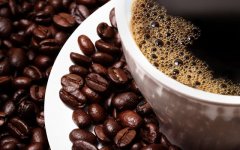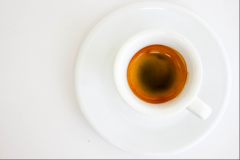Coffee language | how to express a cup of coffee in language?

For professional baristas, please follow the coffee workshop (Wechat official account cafe_style)
● texture, taste (Body,Mouthfeel)
Texture refers to the thick and slippery touch of coffee in the mouth, which is proportional to the amount of colloid suspension in the coffee. Since the texture is felt throughout the mouth, we use "rich" to describe thick coffee, while vice versa, we use "thin". Thin coffee tastes like wine or lemonade, while rich coffee tastes like full-fat fresh milk or even syrup.
● Huigan, Yu Yun (Finish)
Huigan refers to the feeling left by the coffee in the mouth, throat and esophagus after swallowing or spitting it out. Freshness is the main cause of sweetness. After drinking Espresso coffee made from fresh beans, in addition to the aroma of coffee from the mouth to the esophagus and the aftertaste after being stimulated, there will also be a feeling of numbness in the throat that lasts for about two or three minutes, while the whole intoxicating aftertaste will not disappear until 30 or 40 minutes later. Huigan makes your breath so fragrant that you can't bear to drink water to dilute it, which is very different from the uncomfortable spiciness, irritation and dryness of over-extraction.
● Sweet (sweet)
When we say "the soup is very sweet", we do not necessarily mean that there is a lot of sugar in the soup; similarly, sweetness has two meanings in the words that describe the taste of coffee. The first is the stimulation of sugar on the tip of the tongue, that is, the so-called sweetness; the other means that between deep city baking and espresso baking (before and after the start of oil production), due to the disappearance of some astringent substances, give the coffee a low-acid, round, soft and rich sweet taste, reminiscent of syrup; here the tip of the tongue does not have to react.
● irritant, astringent (bitter)
This is the characteristic of deep-baked beans, which, like the sour taste, is not necessarily uncomfortable. The irritation is a bit like the taste of soda, the feeling of the whole mouth and throat, not just the tongue. Generally speaking, friends who drink American coffee or Saifeng coffee may use "strong" to describe this feature.
● earthy, wild (Earthiness,Wildness)
It is usually found in dried coffee that, in a way, it is a flaw in the taste of coffee: it is a slightly irritating feeling like soda, a slightly unpleasant acid mixed with a pleasant acid; the sour taste of mocha is typical. Sometimes a small amount of earthy smell or a slightly irritating smell of ginger can energize the coffee and ── actually makes the senses more awake and sharp.
● Clean (Clean)
Coffee is not rustic, not wild, and has no flaws and dazzling features; washed Colombia is an example.
● smoothing (smooth)
It refers to a sweet espresso that has a weak sour taste and irritation, occasionally with a little sugar and can be comfortably drunk without milk.
● complexity (Complexity)
The high complexity of the different levels of characteristics that coexist in the same cup of coffee means that there are many kinds of sensory stimuli that can be felt; it should be noted that these feelings include Yu Yun, which is not necessarily limited to the present feeling of drinking.
● balance (Balance)
There are features that are complex and interesting enough, but none of them are particularly prominent.
● depth (Depth)
This is a more subjective adjective, which refers to the resonance and appeal beyond sensory stimulation, which is the psychological emotion caused by some meticulous feelings or the complex interaction between different feelings.
Other commonly used vocabularies are aroma, richness, flavor and varietal distinction or character. Wait a minute, I think some of them are literal, and some of them are too vague and beyond my ability, so I won't write any more. Mastering the vocabulary of these flavors not only enables us to introduce the characteristics of coffee beans in different countries in more detail, but also enables us to describe our tastes and be more aware of our preferences.
Important Notice :
前街咖啡 FrontStreet Coffee has moved to new addredd:
FrontStreet Coffee Address: 315,Donghua East Road,GuangZhou
Tel:020 38364473
- Prev

Questions and answers about Coffee for beginners
Professional barista communication please follow the coffee workshop (Wechat official account cafe_style) 1. Is there a certain way to make coffee? There are filter bag type, siphon type, steam pressurized type, dripping type, boiling type, water immersion type and electric type, etc. All kinds of utensils have a certain order of use, the most basic is to be familiar with these procedures, and how to make delicious and mellow coffee
- Next

What is ESPRESSO? Fully explain the meaning of ESPRESSO from six angles
The exchange of professional baristas please follow the coffee workshop (Wechat official account cafe_style) ★ Espresso is a living concerto for the local people living in Italy, Espresso. In the morning, drink a latte (Latte) first. After that, people like to drink Espresso in the store. Everyone waits in front of the bar. After getting the first-hand coffee, they drink it in three sips.
Related
- Beginners will see the "Coffee pull flower" guide!
- What is the difference between ice blog purified milk and ordinary milk coffee?
- Why is the Philippines the largest producer of crops in Liberia?
- For coffee extraction, should the fine powder be retained?
- How does extracted espresso fill pressed powder? How much strength does it take to press the powder?
- How to make jasmine cold extract coffee? Is the jasmine + latte good?
- Will this little toy really make the coffee taste better? How does Lily Drip affect coffee extraction?
- Will the action of slapping the filter cup also affect coffee extraction?
- What's the difference between powder-to-water ratio and powder-to-liquid ratio?
- What is the Ethiopian local species? What does it have to do with Heirloom native species?

